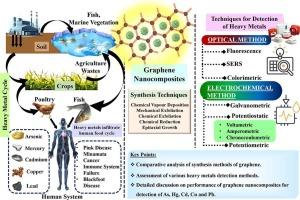Graphene Based Nanocomposites: A State of the Art in Heavy Metal Detection
IF 4.9
2区 化学
Q1 CHEMISTRY, ANALYTICAL
引用次数: 0
Abstract
A massive rise in anthropogenic activities in the last few decades has substantially exposed human life to different heavy metal (HM) with high toxicological implications, when present over permissible limits. Hence, detection of these elements, even in trace amounts, becomes pivotal for maintaining quality of life. Several materials have been employed to serve this purpose, out of which graphene and its nanocomposites have exhibited true potential in detection of HM ions present in various environmental and food samples with very minimal limit of detection (LOD). The excellent large surface area, optical, electrical, thermal, and mechanical properties of graphene bestow the hybrid materials with true potential to serve as appropriate sensing platforms for HM ions. This review provides a concise view towards graphene, its derivatives, detection methods, and utilization of graphene in sensing of mercury, arsenic, cadmium, lead, and copper ions in different media. Latest development of smart graphene-based nanostructured biosensors in the last decade, which reveal extraordinary selectivity and sensitivity towards these hazardous substances with unparalleled stability enabling them an essential tool in the field of environmental remediation, are also highlighted in this review.

石墨烯基纳米复合材料:重金属检测的最新进展
在过去的几十年里,人为活动的大量增加使人类的生命大量暴露于具有高毒理学影响的不同重金属(HM)中,当其含量超过允许的限度时。因此,检测这些元素,即使是微量的,对维持生活质量至关重要。为了达到这一目的,已经使用了几种材料,其中石墨烯及其纳米复合材料在检测各种环境和食品样品中的HM离子方面表现出了真正的潜力,并且检测限非常小(LOD)。石墨烯优异的大表面积、光学、电学、热学和机械性能使这种混合材料具有真正的潜力,可以作为HM离子的合适传感平台。本文简要介绍了石墨烯及其衍生物、检测方法以及石墨烯在不同介质中汞、砷、镉、铅和铜离子检测中的应用。在过去十年中,基于石墨烯的智能纳米结构生物传感器的最新发展显示出对这些有害物质的非凡选择性和敏感性,并且具有无与伦比的稳定性,使其成为环境修复领域的重要工具。
本文章由计算机程序翻译,如有差异,请以英文原文为准。
求助全文
约1分钟内获得全文
求助全文
来源期刊

Microchemical Journal
化学-分析化学
CiteScore
8.70
自引率
8.30%
发文量
1131
审稿时长
1.9 months
期刊介绍:
The Microchemical Journal is a peer reviewed journal devoted to all aspects and phases of analytical chemistry and chemical analysis. The Microchemical Journal publishes articles which are at the forefront of modern analytical chemistry and cover innovations in the techniques to the finest possible limits. This includes fundamental aspects, instrumentation, new developments, innovative and novel methods and applications including environmental and clinical field.
Traditional classical analytical methods such as spectrophotometry and titrimetry as well as established instrumentation methods such as flame and graphite furnace atomic absorption spectrometry, gas chromatography, and modified glassy or carbon electrode electrochemical methods will be considered, provided they show significant improvements and novelty compared to the established methods.
 求助内容:
求助内容: 应助结果提醒方式:
应助结果提醒方式:


